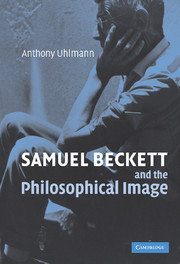Book contents
- Frontmatter
- Contents
- Acknowledgements
- Introduction
- 1 Representation and presentation: Deleuze, Bergson, Peirce and ‘the image’
- 2 Beckett's aesthetic writings and ‘the image’
- 3 Relation and nonrelation
- 4 The philosophical imaginary
- 5 Cogito nescio
- 6 Beckett, Berkeley, Bergson, Film: the intuition image
- 7 The Ancient Stoics and the ontological image
- Conclusion
- Notes
- Works cited
- Index
Introduction
Published online by Cambridge University Press: 22 September 2009
- Frontmatter
- Contents
- Acknowledgements
- Introduction
- 1 Representation and presentation: Deleuze, Bergson, Peirce and ‘the image’
- 2 Beckett's aesthetic writings and ‘the image’
- 3 Relation and nonrelation
- 4 The philosophical imaginary
- 5 Cogito nescio
- 6 Beckett, Berkeley, Bergson, Film: the intuition image
- 7 The Ancient Stoics and the ontological image
- Conclusion
- Notes
- Works cited
- Index
Summary
in relation to intelligence, the image is the condition of thought; ‘there is no thought without an image,’ because the image is the material through which intelligence contemplates the universal.
Ever since people have written about Beckett it has been noticed that he is a writer who is, even more than usual, interested in images. A good deal of work has recently been done concerning Beckett's interest in, and use of, images from the visual arts. Most famously, Beckett told Ruby Cohn that he had remembered a Casper David Friedrich painting, Two Men Looking at the Moon, which he had seen during his trip to Germany prior to World War Two and had adapted this image, staging it in En Attendant Godot. Working from a diary Beckett made while travelling through Germany and visiting art galleries before World War Two, and directed by comments made by Beckett himself, James Knowlson has convincingly displayed how Beckett made use of images from paintings which had had a forceful impression on him and reconfigured them in developing his own striking images in later works. Might the same be claimed for Beckett's use of philosophy? That is, did he borrow images used by philosophers and reuse them in his texts? Furthermore, what, in effect, is an ‘image’; what can it do, and what does Beckett make it do?
- Type
- Chapter
- Information
- Samuel Beckett and the Philosophical Image , pp. 1 - 4Publisher: Cambridge University PressPrint publication year: 2006



